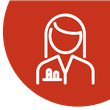

DEPARTMENTS

WOMEN IN IH
JOY JACOBSEN, MS, CIH, CSP, CRSP, EP, is an environmental engineer at Amsted Rail in Keokuk, Iowa. She is chair of the AIHA Women in Industrial Hygiene Committee and vice chair of the Respiratory Protection Committee.
Send feedback to The Synergist.
Continuing the Conversation: OEHS for Women
BY JOY JACOBSEN
On March 8—that is, International Women’s Day—a panel discussion held by AIHA’s Women in Industrial Hygiene volunteer group, the American Society of Safety Professionals’ Women in Safety Excellence common interest group, and the National Safety Council’s Women’s Division explored issues facing women in the occupational and environmental health and safety profession and women’s safety more generally. Panelists included ASSP’s CEO Jennifer McNelly, NSC’s CEO Lorraine M. Martin, and Sue Marchese, AIHA’s managing director of marketing and communications.
This panel was necessary because systemic barriers still exist to women’s safety in the workforce. For example, most of OSHA’s permissible exposure limits haven’t been updated since they were established in 1970 and were based on studies of workers conducted even earlier, when men comprised a significant majority of the workforce. The PELs are therefore not only out of date but derived from science that largely ignored the effects of workplace exposures on women.
Similarly, Martin noted that women are 73 percent more likely to be injured in a car crash, and account for 17 percent more fatalities, compared to men. This is because crash tests predominantly use dummies based on the male anatomy. In addition, Marchese observed that personal protective equipment manufacturers have historically catered to a male workforce, and McNelly shared that, until February 2022, female pilots in the United States military wore flight suits designed for men.
According to McNelly, today’s OEHS professionals need to ask questions that were not asked in the past, elevate voices that have unique experiences and opinions, and provide safe environments for these voices to be heard and influence decision-makers. Workers need to know that there won’t be any repercussions for raising concerns about health and safety.
“I have always known intrinsically that voices save lives,” McNelly said. “We have to make sure that we hear from folks, that people feel safe to speak up, and that when we have that input, we can do the right things to keep everyone safe.”
Systemic obstacles affect not only the health and safety of women but the opportunities available to them for professional development and advancement.
ELEVATING OURSELVES—AND OTHERS
Systemic obstacles affect not only the health and safety of women but the opportunities available to them for professional development and advancement. According to the panelists, women OEHS professionals can elevate themselves by knowing their craft, solving problems, volunteering for difficult tasks, and demonstrating leadership. McNelly added that her experience as an officer in the military taught her an important lesson that applies to all workplaces: respect rank, but don’t fear it, because each person has something valuable to contribute. If opportunities for advancement aren’t available at their current organizations, McNelly advised women to seek those opportunities elsewhere.
The panelists agreed that helping each other is just as important as helping ourselves. As Martin said, “I have to be willing to put myself at risk to advance someone else who is doing the right thing.” Our focus, according to Marchese, should be on pulling each other up rather than competing with each other. Success requires entire organizations to commit to protecting women and removing obstacles to their advancement—and male allies will be necessary. If women are the only ones discussing these issues, half the voices are missing.
Both men and women can benefit from training that helps us recognize our unconscious biases and from joining an employee resource or volunteer group focused on diversity, equity, and inclusion. We can show up prepared to learn and ask questions. We can mentor people who don’t look like us, and we can sponsor and promote rising stars.
FROM EQUALITY TO EQUITY
For a long time, women have asked for equality, but in the realm of health and safety, what everyone needs is equity. Equality means that people are allowed the same opportunities; equity recognizes each person’s different circumstances and allocates the necessary resources to achieve equal outcomes. Without equity, people are left behind, and as our panelists pointed out, the OEHS profession is one of service to all people.
RESOURCES
Fast Company: “10,000 Women Die in Car Crashes Each Year Because of Bad Design” (August 2021).
National Safety Council: Safety Organization Cooperative Panel Discussion (March 2022).